Foraging is the New Black: How to Forage for Food this Fall
Fatten up on nature’s pantry before the winter slumber: Here are 10 wild foods to harvest now.
Foraging is the New Black: How to Forage for Food this Fall
Fatten up on nature’s pantry before the winter slumber: Here are 10 wild foods to harvest now.
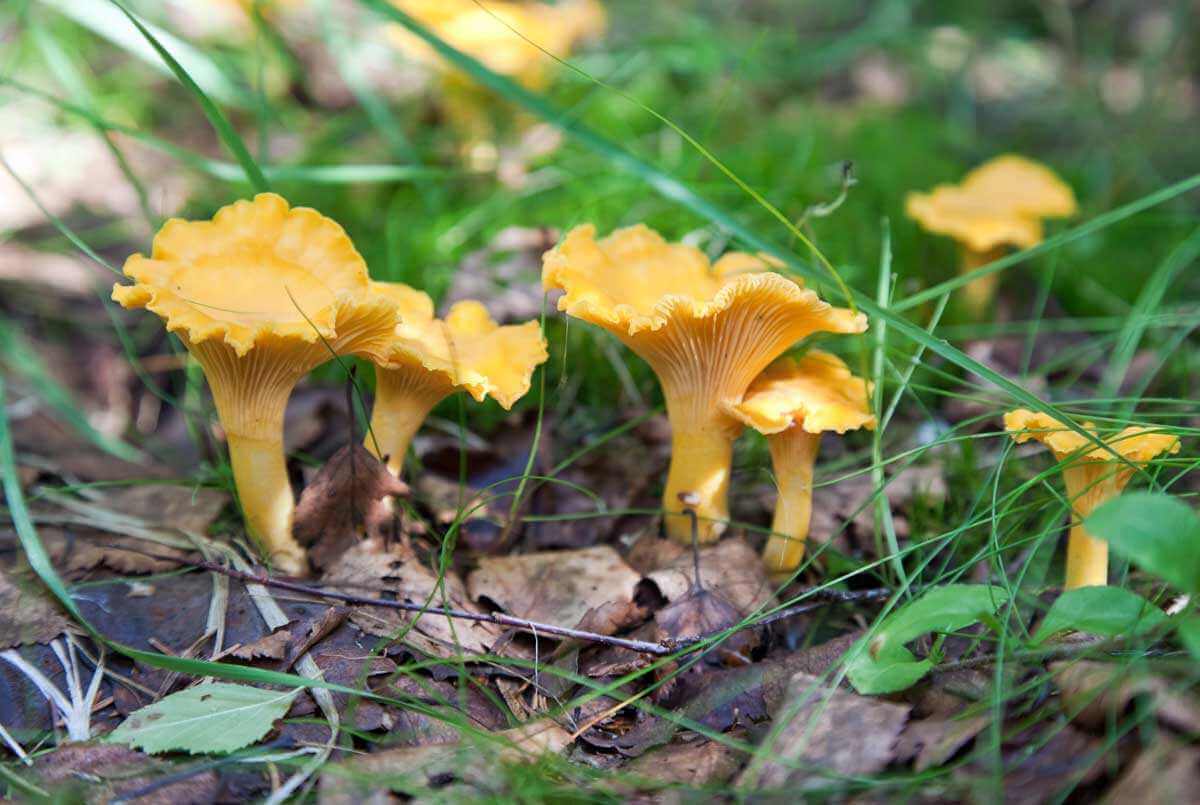
We proclaimed on our Fall issue’s cover that foraging is the new black. It is certainly having a moment of coolness, but of course foraging is nothing new—we’ve been searching for food in the wild for much longer than we’ve been farming. Maybe it’s about time, then, that we’ve come back around to this age-old way of eating.
Just like farms, nature puts out its biggest bounty in autumn. Fresh greens like sorrel and miner’s lettuce are abundant in fields and forests in springtime, but in the fall, foragers look to native fruits, roots, nuts, and fungi. Below are 10 foods you can find now. But beware, foraging is has its pitfalls: You can die from eating the wrong thing, destroy the environment by traipsing around on sensitive habitat, and decimate plant populations by greedily over-harvesting. If you’re going to forage, be ethical about it.
[mf_h1 align=”left” transform=”uppercase”]FRUITS[/mf_h1]
American Persimmon
Most folks are familiar with Asian persimmons – the giant neon orange orbs in the specialty produce section at the grocery store this time of year – but they have an American cousin hiding out in the hardwood forests of the eastern US. American persimmons are smaller, but they have a rich, velvety texture and taste as though they’ve been seasoned with a touch of allspice. Don’t try to eat them until they’ve become completely soft, however; the astringency of unripe persimmons is legendary for its ability to make your mouth pucker.
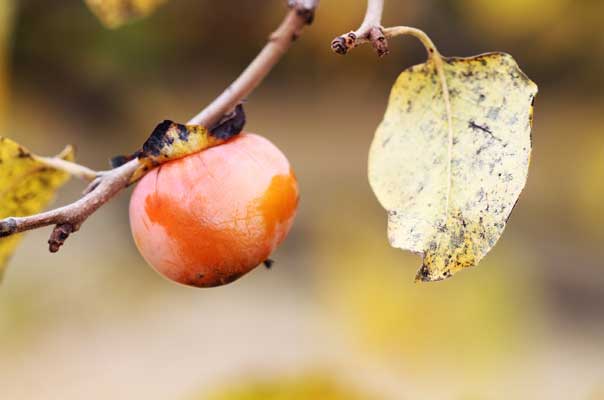
Pawpaw
Pawpaws are the largest fruits native to North America. They are closely related to tropical fruits like cherimoya, but are found growing in the bottomlands of the eastern US from northern Florida to southern Ontario and west as far as Texas and Nebraska. The trees are often found along riverbanks where they grow in dense thickets. Pick them once the skin turns from green to yellow and the flesh is slightly soft when squeezed. Some pawpaw enthusiasts say the fruit is best after the first frost of fall.

Madrone Berries
There are plenty of wild fall fruits out west, too. Not the least of which are madrone berries, the marble-sized fruit of one of the most iconic western trees. Wait until madrone berries are deep red in color, otherwise the flavor is insipid. They have a dryish texture, making them better for baking or adding to a bowl of granola than for eating fresh.
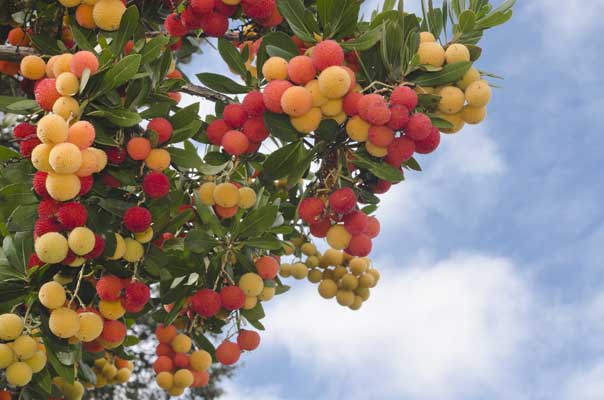
[mf_h1 align=”left” transform=”uppercase”]ROOTS[/mf_h1]
Burdock
Also known as gobo, burdock root has an earth artichoke-like flavor. It is a popular vegetable in parts of Asia, but in America you’re more likely to see it growing as a weed in a pasture than being cultivated in a farmer’s field – it grows in every corner of the country except the Deep South. Burdock has enormous fuzzy leaves the size and shape of an elephant’s ear and taproot that can be several feet long. It’s a biennial, meaning it produces leaves the first year, then flowers, then sets seed and dies in year two. For tender, tasty roots, you need to harvest burdock root at the end of the first growing season – once the flowerstalk appears in spring of the second season of growth, the roots become tough and bitter.

Groundnut
Groundnut is a perennial leguminous vine with egg-sized tubers that can be cooked and eaten like potatoes. Preferring wet, low-lying land, the vines clamber over shrubs and trees in thickets from Florida to North Dakota, Texas to Maine. The flavor of the tubers sweetens after the first hard frost of fall turns the foliage brown. Dig them up carefully to avoid cutting into the edible part and follow the string-like roots to find the buried tubers that are scattered around the base of the vine. Harvesting the roots kills the plant, so be sure to replant a few of the tubers in the same area.
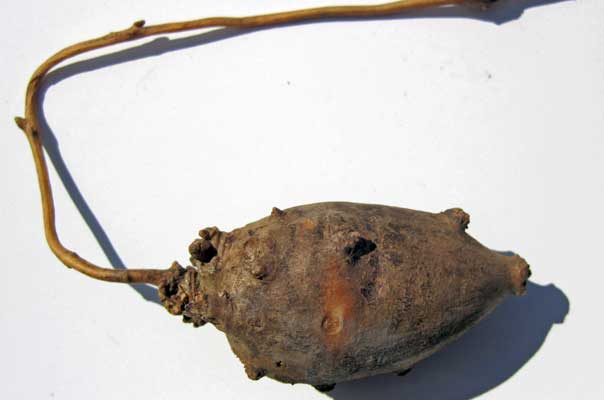
[mf_h1 align=”left” transform=”uppercase”]NUTS[/mf_h1]
Acorns
There are dozens of oak species found across North America, and every one of them produces edible acorns. Acorns were a staple food source for aboriginal groups, but they are not the type of nut you can pick off the tree and pop in your mouth – they are extremely inedible without a bit of processing first. Fresh acorns are full of bitter tannins, which were traditionally leached out in a stream of fresh running water for several weeks, but not before drying, shelling, and grinding them up into flour. For those that don’t have a clean, clear stream at their disposal, the tannins can also be removed by leaching acorn flour in mason jars by decanting the water daily for a week or so.

Hazelnut
Grocery store hazelnuts (also known as filberts) are descended from European trees and are cultivated by farmers on a large scale. North America has its own native hazelnut species, which are just as tasty, but have never been developed into an agricultural crop. North American hazelnuts grow as large shrubs at the edge of forests and are found in almost every state outside of the Southwest. The nuts have little caps on them with fine hairs that can irritate bare skin, so a pair of gloves is recommended when harvesting.
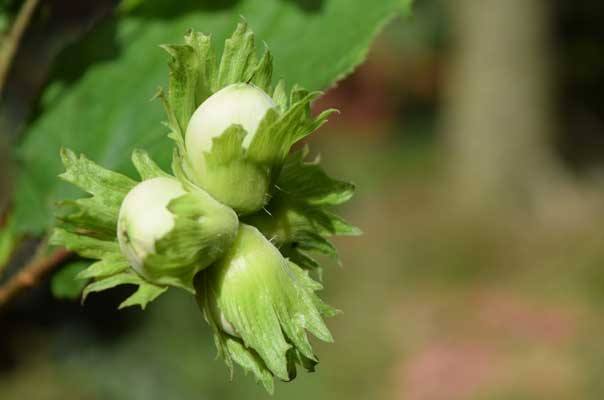
Pine Nuts
Pine nuts are unique to the southwestern states and California, where they are harvested from various species of pinyon pine. Other varieties of pines may have tiny nuts inside their cones, but are considered too small or insipid for eating. Pinyon pines are most abundant at elevations above 5,000 feet and should be harvested just as the cones are turning from green to brown. Be prepared to get covered in pine sap and spend hours shelling the tiny nuts – exactly why wild pine nuts are so expensive to buy.

[mf_h1 align=”left” transform=”uppercase”]FUNGI[/mf_h1]
Caution: Many wild mushrooms are lethally poisonous. Never consume wild mushrooms unless you are 100-percent certain of their identity.
Chanterelles
The season for each species of wild mushrooms varies considerably based on location, but chanterelles are one that is commonly available throughout the country in fall. They like cool weather and tend to emerge in the forest after a soaking fall rain. Chanterelles are one of the easiest mushrooms to identify – they have rib-like ridges on the underside, rather than the fine gills found on so many other species – but make sure to harvest them with an experienced friend until you are completely confident of your ability to tell them apart from potentially poisonous species.
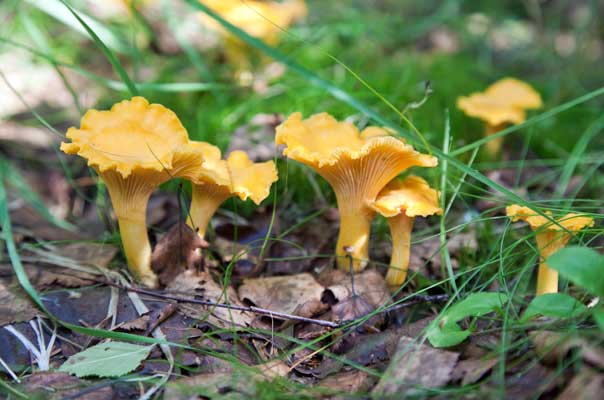
Hen of the Woods
Also known as maitakes, hen of the woods grow throughout the US and are found sprouting from the base of hardwood trees, especially oaks. They parasitize the trees, so you’re most likely to find them on dead or dying trees. Hen of the woods grow in huge layered clumps the size of a chicken or larger, so if you find just one, you have enough to eat for the rest of fall. With a woodsy, smoky flavor and firm texture, they are one wild mushroom that even the most non-adventurous eaters usually enjoy.

[mf_h1 align=”left” transform=”uppercase”]STUCK IN THE CITY?[/mf_h1]
Join an urban foraging guild and put unharvested food to good use.
If foraging is the new black, urban gleaning is its grittier, punk-rock subgenre. Most people with fruit trees in their yard eat only a fraction of the harvest, letting most of it rot on the ground where it feeds only rodents. Some urban foragers are from the freegan camp, focused on feeding themselves without spending a dime (and unafraid to venture into a dumpster if it’s necessary to do so); others, like this Minnesota couple, aspire to turn wasted food into haute food products, like wine (which they sell to foodies for big bucks); but for most, is comes from a passion to help those in need, like this California group, which donates foraged food to food banks.
More and more cities have a local foraging group, often with databases to track the location of trees in need of harvesting and weekly meetups to go and do the dirty work. Yes, there are legal implications, but the more established groups have waivers for property owners to sign, absolving either party (the foragers or the property owners) from liability for any mishaps that may occur (falling off ladders, slipping on rotten fruit, getting stung by the yellow jackets that swarm ripening fruit trees, etc).
Urban Foraging Resources:
The Urban Farmers
The Urban Gleaners
Falling Fruit
SaveSave
Follow us
This work is licensed under a Creative Commons Attribution-NoDerivatives 4.0 International License.
Want to republish a Modern Farmer story?
We are happy for Modern Farmer stories to be shared, and encourage you to republish our articles for your audience. When doing so, we ask that you follow these guidelines:
Please credit us and our writers
For the author byline, please use “Author Name, Modern Farmer.” At the top of our stories, if on the web, please include this text and link: “This story was originally published by Modern Farmer.”
Please make sure to include a link back to either our home page or the article URL.
At the bottom of the story, please include the following text:
“Modern Farmer is a nonprofit initiative dedicated to raising awareness and catalyzing action at the intersection of food, agriculture, and society. Read more at <link>Modern Farmer</link>.”
Use our widget
We’d like to be able to track our stories, so we ask that if you republish our content, you do so using our widget (located on the left hand side of the article). The HTML code has a built-in tracker that tells us the data and domain where the story was published, as well as view counts.
Check the image requirements
It’s your responsibility to confirm you're licensed to republish images in our articles. Some images, such as those from commercial providers, don't allow their images to be republished without permission or payment. Copyright terms are generally listed in the image caption and attribution. You are welcome to omit our images or substitute with your own. Charts and interactive graphics follow the same rules.
Don’t change too much. Or, ask us first.
Articles must be republished in their entirety. It’s okay to change references to time (“today” to “yesterday”) or location (“Iowa City, IA” to “here”). But please keep everything else the same.
If you feel strongly that a more material edit needs to be made, get in touch with us at [email protected]. We’re happy to discuss it with the original author, but we must have prior approval for changes before publication.
Special cases
Extracts. You may run the first few lines or paragraphs of the article and then say: “Read the full article at Modern Farmer” with a link back to the original article.
Quotes. You may quote authors provided you include a link back to the article URL.
Translations. These require writer approval. To inquire about translation of a Modern Farmer article, contact us at [email protected]
Signed consent / copyright release forms. These are not required, provided you are following these guidelines.
Print. Articles can be republished in print under these same rules, with the exception that you do not need to include the links.
Tag us
When sharing the story on social media, please tag us using the following: - Twitter (@ModFarm) - Facebook (@ModernFarmerMedia) - Instagram (@modfarm)
Use our content respectfully
Modern Farmer is a nonprofit and as such we share our content for free and in good faith in order to reach new audiences. Respectfully,
No selling ads against our stories. It’s okay to put our stories on pages with ads.
Don’t republish our material wholesale, or automatically; you need to select stories to be republished individually.
You have no rights to sell, license, syndicate, or otherwise represent yourself as the authorized owner of our material to any third parties. This means that you cannot actively publish or submit our work for syndication to third party platforms or apps like Apple News or Google News. We understand that publishers cannot fully control when certain third parties automatically summarize or crawl content from publishers’ own sites.
Keep in touch
We want to hear from you if you love Modern Farmer content, have a collaboration idea, or anything else to share. As a nonprofit outlet, we work in service of our community and are always open to comments, feedback, and ideas. Contact us at [email protected].by Brian Barth, Modern Farmer
November 5, 2015
Modern Farmer Weekly
Solutions Hub
Innovations, ideas and inspiration. Actionable solutions for a resilient food system.
ExploreExplore other topics
Share With Us
We want to hear from Modern Farmer readers who have thoughtful commentary, actionable solutions, or helpful ideas to share.
SubmitNecessary cookies are absolutely essential for the website to function properly. This category only includes cookies that ensures basic functionalities and security features of the website. These cookies do not store any personal information.
Any cookies that may not be particularly necessary for the website to function and are used specifically to collect user personal data via analytics, ads, other embedded contents are termed as non-necessary cookies.